If the YouTube video above is not available, here are two other ways to view:
Transcript
We’re looking at the Gospel, which has three parts. Christ died, we looked extensively at that. He was buried and then praise God He rose. We’re going to look at the truth of that. Tonight, we’ll discuss that He was buried. One of the truths of the burial is this, Jesus Christ was buried right next to the place we saw last time, where He was crucified. There are two elements about His burial in the next slide that we need to look at. His burial was physical. There had to be a physical body put in a physical tomb because the scriptures knew, and the Lord saw that the attack was going to be on Christ being separate from the man. It was a physical burial and we saw that in 1 John, next slide. Reminding us of that is that in His burial, He was put into a real tomb that had to be hewn out of the ground. I might just detach from the slides. There’s one in the next slide.
It was strategic. Jesus Christ had to be placed in the ground to fulfill the Feasts. Remember that the entire celebration of the Passover, and then the celebration of Unleavened Bread, and then the celebration of First Fruits exactly paralleled Christ presenting Himself as the Passover lamb. He bore our sin, the Feast of Unleavened Bread when all leaven was put out of the house as a picture of iniquity. Then the first Sunday after that Passover was the Feast of First Fruits and Jesus was foretold in the scripture that He would be firstborn from the dead. It was a very strategic event, His burial that would coincide with all of the wonderful, prophetic pictures of Christ.
Next slide. I showed you that tomb that was hastily prepared. It has wrought iron. The next slide. Christ’s burial was verifiable. We looked at that in-depth, especially in the fact that Pilate had to verify with the Centurion, centurions were executionists. For those who hold to this resuscitation view, it’s called the Swoon Theory, that Christ merely went into this coma and was just acting dead then came back in the coldness of the tomb, God had an answer for that. Just like He had one for the gnostic view and that was that of Jesus, His burial was verified by the highest authority of the land who affirmed through his centurion’s witness, that He was dead. Then Pilate followed through and said, I charge you to go bury Him and set a seal, he told those religious leaders to set a seal. Those religious leaders set a seal affirming what Pilate had said, what the Centurion had said, that Jesus had died and that He was buried. It was very verifiable.
It was also anticipated. Christ’s death was anticipated by of course Nicodemus as he, we saw last time, was sent by the religious leaders and they said you go search the scriptures. He searched the scriptures and found that Jesus would be the lamb, that was the Passover lamb. The one that was lifted up and the one that would be buried with the rich. He was the one that anticipated and found a friend and that friend is who we’re looking at tonight. Here again, right in the shadow of the crucifixion area, the events are in full.
Next slide. Christ’s burial was costly. There had to be a lot done, the next slide reminds us of that. Out of solid rock, they had to actually carve out a niche for His body to go in. When Joseph of Arimathea took this upon himself, he went, as we saw last time, and purchased a tomb right next to the execution spot. Which was a strange thing because he wasn’t from that area because no one wanted to be buried by a garbage dump. No one wanted to be buried by a place where screams and agony echoed around night and day. He, in an expensive way, carved the tomb of a rich man for Jesus Christ.
Next slide. They gave their time to Jesus. We saw that one of the great things about Nicodemus and Joseph is this: that they loved Jesus so much that the first expression of that was their time. They spent the time studying. They spent the time researching what it was that He was going to do. Then they spent their time getting down what needed to be done. They thought we’ve got to get this tomb. We’ve got to get these spices. We’ve got to get right there knowing the timing of His death so that we can be involved. They gave their time. I want you to think about this. I mentioned that this morning. We who have so much liberty in Christ, are we in such bondage to our schedules, and to our lives, and to our plans for our careers, and all of the various cares of this world that we cannot also give our time to Jesus? I thought about the hymn we were singing this morning. It talked about an hour spent when with thee I commune as friend with friend. An hour? Do we spend an hour with the Lord? What a reminder to us, even in the burial of Christ that these men gave their time to Jesus.
Next, they gave their treasures to Jesus. This lovely tomb, as a reminder in the next slide, shows us that they actually went through all the investment that it took to make this a place where there was a garden, it says in the Gospel of John. Another thing to think about in relation to the treasures is when Joseph of Arimathea prepared this tomb for Jesus Christ. What he could have done is just made a little niche just to stick Him in because it was going to be a very brief thing, but he didn’t. He made a full-blown carved stone tomb, and he also purchased a garden that surrounded it. It says in the scriptures we call it the garden tomb because that’s what John calls it. Joseph purchased this garden and the remnants of it are still there today as you can see in the slide. It’s a full-blown working wealthy person’s inner-city garden.
He gave his treasures to Jesus knowing, as I shared with you last time, that according to Jewish ceremonial law, no descendant of Joseph’s could ever be buried in that tomb. He lost it. There’s something about giving to Jesus something I can’t recover. Always through the scriptures, God emphasizes that. Remember the widow irrecoverably gave the last of her wealth, her mites to Christ. Do you remember David? The man after God’s own heart, when he got that offering by his three mighty men of the water from the well where he grew up, it was so important to him. He could have consumed it and that would have made it really a wonderful moment. What did David do with that water that was so precious? He poured it out. At that instant, when he poured out that water, he made it last forever because he could never recover it. When he consumed it, it would pass, but he didn’t consume it. He poured it out irrecoverably to the Lord.
Do you remember when the woman came at night, so aware of her sinfulness and began to weep and she washed Christ’s feet with her hair? She poured and broke her alabaster vial over Jesus’ feet. She irrecoverably gave up her treasure. She could’ve kept that. It was worth, they say, a year’s worth of wages or more. She could have kept that because she was a woman, she was alone, she didn’t seem to be married or to have a future or livelihood. She could have kept that and said, I’m going to keep this to serve the Lord to the end of my life. What’s interesting is that the Lord loves irrecoverable sacrifices that we can’t get back. That’s what Joseph gave to Christ, his time. He could never take it back. The woman gave her treasure. She could never recover it.
Tonight, let’s go through the elements of Christ’s burial. We’ll go through the incredible details one at a time. In John 19, we’re going to see these details starting in verse 34, that at Christ’s burial He had a side that was pierced. I already told you about this. One of the soldiers pierced His side with a spear because the Romans would not permit a crucified man to be taken down before he was dead. Jesus, before He could be buried, had to have His side pierced. I went through with you last time that death thrust. As those soldiers knew how to get that spearhead up into the very heart of the victim. As Christ was hanging, they just wedged that head of the spear just under His ribs and made sure that they punctured His heart. His side was pierced.
Now you say, is there any significance? It’s very interesting. The hole that would make in the side of His body was almost prefigured in Exodus. When God appeared to Moses and Moses said, show me Your glory. God said nobody can see me without being consumed, but I’ll tell you what I will do for you. I will let you see the backside of me, and I will let you hide in the cleft of the rock. Do you know what the cleft is? It’s a kind of crevice. It’s just a little outcropping of the rock where he could hide down in that little valley and the Lord put His hand over him in that little valley and passed by.
That’s where the songwriter says, “He hideth my soul in the cleft of the rock.” Jesus was the rock. The cleft was His riven side where we hide from the wrath of God as His sacrifice. That’s where the songwriters get that from, the experience of Moses being protected from the glory of God, which would consume him because of his sinfulness. He wasn’t consumed because he was hiding in the cleft of the rock covered by the hand of the Lord. As He went by the Lord declared, the Lord God, merciful and gracious, which is what the sacrifice of Christ declared.
Secondly, and the next slide tells us as we get to that, Christ’s burial had a witness chosen. Look at verse 38. “After this, Joseph of Arimathea, being a disciple of Jesus.” That was his first credential. He was a follower, a learner, one who had believed in Jesus, but secretly. I reminded you last time that this witness that God chose for Christ’s burial would not have been the one we might have chosen. We would have maybe chosen Peter or John or James or Andrew, at least someone that had shown a little bit of initiative and had followed Christ. This man had, as it says in this 38th verse at the beginning, “for fear of the Jews” had secretly followed Jesus. We would have gone like this. You’re not a very good disciple. You shouldn’t be afraid. God took him where he was, and God accepted him where he was. Even though he was afraid he truly wanted to follow Christ and did. He struggled with fear. Remember I said this morning, besetting sins. His trouble was fear. He feared he would lose his place in the council, his wealth, perhaps he might lose his life or his family. I don’t know all of his fears, but God chose him as the witness. In verse 38, he asked Pilate that he might be the one to do this burial. He was the witness God chose.
In the last part of verse 38, and as we go to the next slide this is another tomb. Christ’s burial had a price to be paid. Look what it says at the end of verse 38. It says, “After this, Joseph of Arimathea, being a disciple of Jesus, but secretly, for fear of the Jews, asked Pilate that he might take away the body of Jesus; and Pilate gave him permission.” By the way, probably no one heard that, just Pilate and his guard. This was a very sober day. A lot of strange stuff had happened. There had already been this mighty earthquake that shook Jerusalem. There had already been three hours of impenetrable darkness. There had already been this amazing, incredible day. He probably had heard already about the veil being torn and those graves popped up. I’m sure that Pilate was in the Antonian fortress with his mightiest men around him. He didn’t know what was going to happen next. It was okay for Joseph to do this because nobody would have known about it, but the soldiers and they didn’t care.
Look at the end of the verse, this is the price that had to be paid. What did it cost Joseph to bury Jesus? He had to come and finally publicly identify with Christ. See, he went to the cross where everyone knew where Jesus was. That was one of the things about Christ’s ministry, He could only be in one place at one time. Think about that because the resurrection freed Jesus up to no longer only be able to be in one place at one time. He was with me this week. I don’t know where you were this week, but I know that Jesus was with me. You don’t know where I was this week, but I think if you’re saved, that He was with you and that is the blessing of the resurrection we’re going to see next time. Jesus was freed to no longer be merely in Galilee or merely up in Nazareth somewhere or over in Jerusalem. He could be anywhere with anyone at any time.
Joseph was identified and he was willing to pay a price. Joseph of Arimathea, Mark tells us, and I’ll read a parallel passage, Mark 15:43, “A prominent member of the council.” He was very well known. He was probably prominent because, in the Jewish minds, the most prominent thing you could have was wealth. They always thought that wealth equated favor with God. This man was vastly wealthy. It says he was a wealthy man, but he was prominent, and this word means he was very well-known probably because of his wealth. He was himself waiting for the kingdom of God. Mark says he went boldly to Pilate. It’s almost like something snapped inside of him. The connection was made, and he who had secretly followed Christ at a distance for fear finally said, I am not ashamed of Jesus Christ. He walked in boldly and I’m sure it would have probably intrigued Pilate that one of these religious leaders was coming so boldly. This is a religious leader that he was not used to, or perhaps even knew. Joseph might’ve had interaction with Pilate on a business level, but he came in boldly, Mark tells us and asked Pilate for the body of Jesus. He took courage, and He went to Pilate boldly.
Only Mark points that out and it’s significant. John just says that he went right in there and asked. Mark underscores the fearless boldness. Wait a minute, Mark, the Gospel by Mark are the words of Peter who was in hiding at this moment when this was going on. The words are written down by the quitter Mark. Isn’t it significant that the Holy Spirit, when years later he guided Mark to write this Gospel recording the words of Peter, that Mark alone would bring out the courage of a former fearful secret agent disciple? Isn’t it neat how the Holy Spirit orchestrates all this? How Mark, who had been fearful and quit, and Peter, who had been fearful and fled, points out that the former fearful secret agent disciple now gets bold, but there was a price to be paid.
It’s interesting. The action of Joseph was bold for several reasons. Number one, he wasn’t related to Jesus. You couldn’t pick up the body of someone except a relative, that was Roman law. Otherwise, they went to the dump, to the pauper’s grave. If they were a criminal, they went to the garbage pile. If they weren’t criminals, they went to the common grave. They had common graves and just threw them in. They find them all over Israel, piles of where there were mass graves. There are no names, they just put them there because they had to be buried. The first thing that was bold was he was not a relative.
Secondly, his request was a favor that would likely be denied on the principle that since Jesus was executed for treason nobody should pick up His body. It was pretty bold because he wasn’t related to Christ, and he went anyway. Also, it was going to be a favor because nobody should have picked up His body because He was a criminal against the state.
The third thing that’s fascinating about this boldness is he risked his ceremonial defilement because he had to personally handle a dead body. At sundown, the highest celebration of the year took place, Passover. It was so important as a member of the council to be able to go into the temple, to be able to go in and represent the nation, to be able to go and to be a part of all that was going on. He was willing to be defiled and lose all that. It was a price to be paid.
Another aspect of the price was that his request amounted to an open confession of his personal loyalty to the crucified Jesus, which would doubtless incur his associate’s hostility. He was a secret disciple no longer, and that’s what Mark is trying to impress on us. I think it’s because Mark had his problems because Peter had his problems. Mark says I want you to realize he was a secret disciple no more. He paid the price. When you put up the flag and let people know, you’ll pay a price too. It will happen if you do it in school.
I’ve told you this before, I’m 48 years old. The last time I went to Haslett, Michigan, and saw my old stomping grounds, I saw at the local grocery store, my old principal. He has not seen me for 30 years. Actually, it had been about 27 years since he hadn’t seen me. I was in the local grocery store and the principal said, Deacon Barnett, good to see you. Deacon Barnett. That was a term of disparagement. They always remembered me in school because they said you’re the one that started all those Bible studies. You put your flag up. That was not a positive thing to be called a deacon at Haslett High School. When I went to Michigan State University I questioned the professors about their morality and about making fun of God. From that point onward, the entire time I went to Michigan State when those professors saw me, they just pointed and smirked. They’d laugh. There’s a price to pay, to put up your flag. When I was a truck driver, I would get up from the break room. I wouldn’t listen to dirty stories and so they wouldn’t talk when I was in the break room. They’d all they don’t stop and just look at me. They’d say he’s here; we can’t tell our stories. See, there’s a price.
Those are small prices to pay, but what you’ll find out is that there’ll be parties you won’t be invited to. There’ll be events that no one will tell you about. There’ll be times when people stop talking. It’s even worse as our brothers and sisters around the world are experiencing. Those other things are not persecution compared to what they’re experiencing in Iraq. What they’re experiencing in Israel, what they’re experiencing in Russia and in India. He paid a price. There’s a price to be paid.
The man who started off with confusion at night, Nicodemus, ended up with an open confession in the daylight. Nicodemus came with Joseph out of the dark, into the light, and with Joseph, he was not ashamed to publicly identify with Jesus Christ. There was a price to be paid. When those two men touched Christ’s body, they defiled themselves and would not be invited to participate that night in the Passover. Do you know what I always think about? What difference did it make that they could no longer celebrate the Passover that night? Because they had held the Passover lamb Himself who came to take away their sins. I’m not sure how much they knew, but I do believe that Nicodemus knew what Jesus had told him. That as the Son of Man would be lifted up, as Moses lifted up the serpent, so the Son of Man would be lifted up. That “whoever believed in Him would not perish, but have everlasting life.” Can you imagine the thrill on Nicodemus’ heart as he climbed up whatever he had to climb up and loosen the body of Christ and, with Joseph, lower down and hold in his own arms, his sacrifice for his sins. What a thrill. I guess that would be worth paying a price for. They had found the lamb of God.
Verse 39 and the next slide tell us the next aspect of Christ’s burial, it had a scripture fulfilled. It says in verse 39, “Nicodemus, who at first came to Jesus by night, also came.” At the critical council meeting that we looked at last time in John 7, Nicodemus boldly stood up and defended the Savior. His associate’s ridiculed him for thinking that a prophet would come out of Galilee. They said, search the scripture. He did with Joseph; they quietly searched the scripture and together they were convinced that Jesus of Nazareth was indeed Israel’s Messiah. They saw as they came, that Christ was the scripture they had been called to search. They found that Jesus was that scripture fulfilled. They found that He was the one, as Isaiah had said very clearly in Isaiah 53, that He would make His grave with the wicked and with the rich in His death. At the same time that Jesus was being lovingly lowered from the cross into the arms of Joseph and Nicodemus, there were some hired workmen who were crudely pulling off from the cross, the corpses of those thieves. Jesus went to the grave with one wicked person, the thief who never believed. As Jesus was making His grave with the wicked, I’ll quote Isaiah for you, “He would be buried with the rich in His day.”
Now, some scholars speculate that because the tomb was in such close proximity to Golgotha perhaps Joseph and Nicodemus actually had just waited out the crucifixion in the tomb. They had to sit there and guard their fortune of spices. They could hear everything going on because it was right there. They could have very easily sat in that tomb, and it could be even that with the rich in His death, He was buried with the rich, that was Joseph’s tomb. Joseph probably had come there often to think about the gift he was making for Christ. It could also be that Joseph even sat in there as a prepared and put in Christ’s body. There’s so much surrounding this, but I’m sure Joseph would have thought that it was the Lamb of God they took down from the cross Who had been lifted up as Nicodemus had remembered Christ’s words. The Passover lambs were slain at 3:00 PM so those two men would have almost known exactly the time that God’s lamb would have died on the cross.
Do you think about that? They’d studied enough that they knew Jesus was the Passover lamb. They knew that the lamb tied at the high altar of the temple was slain right at 3:00 PM. Right at 3:00 PM, as the darkness was in its third hour when the high priest executed that lamb, Jesus cried out and gave up the spirit and they knew that their moment had come. I believe that to fulfill the scripture Nicodemus probably stayed back to guard the stuff and Joseph took off and went straight to Pilate. He went there and he wanted to ask for that body because he wanted to be the one, as Isaiah 53 says, to fulfill that He would make His grave with the wicked and with the rich in His death.
The next slide shows us that there’s another facet. Christ’s burial also had a symbol that was completed. It’s interesting what it says at the end of verse 39. It says that “Nicodemus, who at first came to Jesus by night,” who had started this whole thing “also came” look at this, “bringing a mixture of myrrh and aloes, about a hundred pounds.” I don’t know if the next slide shows it, the picture of what myrrh looks like… There it is. Myrrh is, you can see the finished product in the lower left. In the upper left is a man actually harvesting a myrrh tree. Myrrh tree is a neat thing to have in your backyard. What you do is, you take a machete, you go up and you do what kids love to do to trees. You just do your sword fight on it. Every place you cut the tree, it heals itself with a priceless ball of resin that’s called Myrrh. It’s like the sap that comes out of pine trees. Only these thorny, scrubby, wiry little trees that only grow in hostile deserts only will exude fragrant, aromatic, resinous, gummy, secretion if they are severely bruised. Something about myrrh speaks of being crushed. I want you to think about that because Christ’s burial was a symbol completed.
Think of the progression. At Christ’s birth, myrrh spoke of Christ who suffered poverty for us. It says in Matthew 2:11 Wisemen came from the east and brought gold, frankincense, and myrrh. The myrrh then yes, was pointing forward I believe to this moment of His burial, but also it reminds us that Christ suffered poverty at His birth. It isn’t just the cross that Jesus suffered. Jesus suffered all the way through His ministry. The second time myrrh is used is at Christ’s crucifixion where He suffered pain for us. According to the scripture, myrrh was introduced earlier in the crucifixion event. Do you remember that? For just a minute, you’re in John, turn back to Mark’s Gospel. Let me show you something because myrrh shows up in Mark 15 before Nicodemus hauls it into the scene and it shows us another facet.
Myrrh is always associated, if you track it, with climactic moments in Christ’s life. The first one was of course His birth and it spoke of the poverty He suffered for us. Look at Mark 15:23. It says this, let me get down to 23. “Then they gave Him wine mingled with myrrh to drink,” Mark 15:23, “but he did not take it.” Do you know why? This was an anesthetic. It was a pain killer. See myrrh could be taken with wine to deaden. It’s like they had learned back then that this was not just for burial, but it was also something that could be used to anesthetize people so that they didn’t feel. They went into a kind of a daze. Jesus wouldn’t accept that because at His crucifixion He suffered pain for us. His crucifiers were trying to dull His senses so the pain wouldn’t be so bad.
Jesus said no, I want to suffer and drink the cup to the bottom because I want to save all who come to Me to the uttermost. I don’t want them worrying through life that maybe there’s just one sin too many that they will commit and if they do that’s too much, I can’t pay for that. He says, no, I’m going to drink the cup to the bottom. That’s why Hebrews 7, 24, and 25 says that we can come to Him because He saves us to the utmost, all who come to God by Him. To the uttermost means that He saves us until He gets us home. He covers all of our sins; past, present, and future until our last breath. Jesus refused that myrrh.
At Christ’s burial, and back to John 19:39, is the last time myrrh is around. It’s around three times: at His birth, because He suffered poverty, at His crucifixion because He suffered pain, and at His burial, because His suffering paid for us. According to John 19:39, a mixture of myrrh and aloes, about a hundred pounds, was used to prepare the body of Jesus. This is 60, 80, or one hundred pounds, it’s a hundred Roman pounds so it’s less than our English pounds. It was a vast fortune of that spice you saw, but Christ was completing the symbol. Why was Christ buried with myrrh? Because Jesus was crushed for our sins and myrrh speaks of a product of crushing, a product of cutting, a product of pain. Just as that myrrh tree has to suffer to produce the myrrh so Jesus had to suffer to pay the price for our sins.
The next element. Christ’s burial had a body that was buried. Look at verse 40. “Then they took the body of Jesus, and bound it in strips of linen with the spices, as the custom of the Jews is to bury.” The soldiers were through with their gruesome work and our Lord’s friends took over. From that point on, as far as the record is concerned, no unbelievers ever touch the body of Jesus. In fact, from this point onward from when they got possession of that body and were able to cradle it in their arms and take Jesus back to the tomb to clean Him up and put Him in, only loving hands touched Him. From that point onward, only loving eyes saw Him. Did you know that is still true today? Did you know that you cannot touch Jesus Christ if you don’t love Him? You will not see Him again unless you see Him with loving eyes. The next time Jesus Christ is coming. He’s coming in fiery indignation for the lost. Until He comes the only ones that get to see Him are those who love Him. That is what He offers to us.
He says you will seek Me and find Me when you seek with all your heart, When you love me enough to seek me. Until He comes in the clouds when every eye will see Him, He will only be found by loving hearts. He will only be seen by loving eyes. He’ll only be touched by loving faith. God prepared two high-ranking men to prepare His body for burial and to place it in the proper tomb. Had Joseph and Nicodemus not been there it’s likely the body of Jesus would have been carried off to some obscure and accursed ditch and left there with the trash. If the friends of any victims appeared, the Romans were only too happy to give them the bodies to get them off their hands. It was important that His body be prepared for burial so that the empty grave clothes. Could be left behind.
Look at chapter 20. It’s very interesting, in verse 5 and I know we’re going ahead, this is exciting stuff and it’ll be next week if the Lord tarries, but look at this verse 5. I want you to think about that. “And he, stooping down,” John 20 verse 5, “and looking in, saw,” that’s the word blepō, “the linen cloths lying there; yet he did not go in.” That’s a very special use of the Greek language because of verse 6. “Then Simon Peter came.” John was faster. He runs and he blepōed. He stooped down and he looked in. Blepō means he glanced. That’s a Greek word for seeing only it means just a brief look. “Then Simon Peter came, following him, and went into the tomb; and he theōreō.” Blepō even sounds like a blip. That’s probably where we get the English word blip, from blepō, it just blips. Theōreō means you stand there, and you can’t take your eyes off something.
Look what it says, “and he saw the linen cloths lying there,” verse 7, “and the handkerchief that had been around His head, not lying with the linen cloths, but folded together in a place by itself. Then the other disciple,” verse 8, “who came to the tomb first, went in also; and he saw.” A totally different word for see, eidon. We’re going to do this next week, but there’s so much interesting precision in this account. “And he saw,” verse 8, “and believed.” Why does verse 40 say that they had to do this special Jewish burial? Because again, more proof. The Jews were buried in a mummy-wrapping way. I told you this last time that they wrapped the fingers. They wrapped the hands. Then they wrapped the arms around the body and then they wrapped the legs together. Then they wrapped the body all the way up, but they stopped at the shoulders and left the neck. It’s a little gruesome, but I’ll tell you why in a minute. Then they wrapped the head.
The reason they left the neck exposed is that it was accustomed that you put the body on that shelf like I’ve shown you so many times. The reason I’m showing you that shelf is that it was part of the Jewish custom. You wrapped them all up in this special wrapping, and then you wrapped the head, but you left the neck out so that the family members could come and look in the family tomb and after about a year they checked to see how much of grandma was still there. When the neck was only bones, they knew that the rest of the body had decomposed. Then they gathered the bones and put them into a box called an ossuary.
That’s why this is such a beautiful glimpse. They had done Him that way. Jesus was all wrapped up tight, right up to here. Then they wrapped His head and left the neck, showing they had planned for Him to stay there. In the next verse, look at what it says. Verse 9 of chapter 20, “For as yet they didn’t know the Scripture, that He must rise again from the dead.” Joseph and Nicodemus had done the normal and left His neck shown so they could see when He decomposed. For as yet they didn’t know He was going to rise from the dead. That shows that what Jesus did, significantly, was He was laying there on that shelf all wrapped up and He did the same thing that He was going to do in a little while in chapter 20.
Do you remember how Jesus walked through a wall? Yet when they came up, they felt Him and He was really there. Do you remember He walked right through into the room? The door was locked, and He walked right through the wall. Yet when they touched Him and grabbed Him and poked their hands in, and when Thomas stuck his hands in, Jesus was really there. John says I felt Him, yet He could walk through a wall. He did that number in the tomb. He just sat up and sat right out of all those grave clothes, He just went right through. You say, how is that possible? Well, talk to someone who’s deeply involved in physics, and you’ll find out that at the atomic level, almost all of the atom is space. It’s just an electron spinning all over making that shell. Then there’s this little, tiny nucleus and all the rest of that massive atom, if you look at it from the perspective of the size of the particles, is just emptiness.
Scientists have found theoretically that there’s something going on in our universe called dissonance, our whole universe has this dissonance. Everything is out of place. It’s out of kilter. It’s like an old car that’s rattling all the time. Our whole universe is doing that. Paul says in Romans 8 that it’s groaning, waiting for redemption. Jesus was redeemed, His body wasn’t dissonant anymore. There’s enough space if all my atoms were not wobbling and all the other atoms in this hand were the same, I could actually put my hand right through this hand and it would stay complete. I could just do that and yet I would be a complete physical object. That’s what Jesus was. He sat up with His physical body out of those bandages and then He just took this off, or maybe the angels helped Him, and set it down nicely and folded. That way He could show that the body really was buried and that there were no grave robbers. Because the tube that His body had bedded was still there because of all those spices, most likely it still retained the shape of the body. John and Peter came in and looked and there was no body, and the head wrapping was by the side.
Now, the last point we have to get to, to get done tonight. Christ’s burial had a tomb prepared. How did Joseph prepare? It says in verse 41 “Now in the place where He was crucified there was a garden, and in the garden a new tomb in which no one had yet been laid.” Joseph arranged to have that tomb. He arranged to have the clothes and the spices needed for burial. Who knows how he did it, but he prepared that tomb. They could not have secured the tomb at the last minute, they had to have a tomb prepared. Here’s the last one, verse 41, “and in the garden a new tomb in which no one had yet been laid.” Why a new tomb by Joseph? Isaiah 53, the Old Testament’s most beautiful and detailed prediction of the Messiah’s suffering and death, included a prediction that His grave was assigned with the wicked and yet He would be with a rich man in His death. That obscure prophecy would have been impossible to comprehend fully until His burial actually took place.
Now we understand that the Holy Spirit was revealing that although Christ’s enemies intended to bury Him with common criminals God’s plan was that He be buried, not with the wicked, but in the tomb of a wealthy man who by inference was godly. The second prophecy fulfilled was that Jesus’ burial was His own declaration, as “For as Jonah was three days and three nights in the belly of the great fish, so will the Son of Man be three days and three nights in the heart of the earth.” What a beautiful picture then to tunnel into a solid rock mountain and place His body in, as it were, the heart of the earth, as He promised.
What’s the conclusion? What lessons can we draw? Three things I began with last time. Do what you can do. Joseph and Nicodemus didn’t preach, they didn’t go on missionary journeys, they didn’t follow Jesus around. They prepared for His burial. Do what only you can do. Number two, give what you can’t keep. They gave up their time, as we saw tonight, they gave up their future security, they gave up their treasures. All of which are temporary, whether we acknowledge it or not. If we give it and can’t keep it, it’s so priceless to Christ. Finally, they gained what they couldn’t lose. Anything given to Christ will last. Forever we will remember a borrowed tomb and the faithfulness of these two men who risked everything for someone they loved so much. The last point I love, start now. You know they didn’t say, oh, we’ve always been afraid. Oh, we’ve always held back. They didn’t say, oh, it’s too late for me. They just started right now. What I see is do what you can do, give what you can’t keep, gain what you can’t lose, and start now. Don’t be held back by fear because Christ will take what we have and He will accept it, and use it for His glory, and it will last forever. Some great lessons from two men who paid a price to follow Christ.
Father, we stand before You acknowledging Your ownership of us. Humbly acknowledging our failures so often. Painfully we’re aware of them, and yet You love us still. You love us. Praise Your holy name. Tonight, I pray You’d stir our hearts to think about what we can do for You. Not thinking about what everybody else can do. What can we do for You? What can we give to You that we cannot keep? Our time, our love, our strength, our security. When we give it to You, we find it’s going to last forever so we should start doing that now. Not later when things settle down. Not later, when we’re more secure, not later when we finally get what we want, but give it to You now. I pray that You would stir all of our hearts to be like Joseph and Nicodemus, to make a sacrifice of our time and of our treasures to gain what we’ll never lose. Thank You. Their example touches our hearts because You used them. Use us, we pray. In the name of Jesus, and all God’s saints said, amen.
Slides
Check Out All The Sermons In The Series
You can find all the sermons and short clips from this series, 52 Greatest Chapters In The Bible here
Looking To Study The Bible Like Dr. Barnett?
Dr. Barnett has curated an Amazon page with a large collection of resources he uses in his study of God’s Word. You can check it out here.


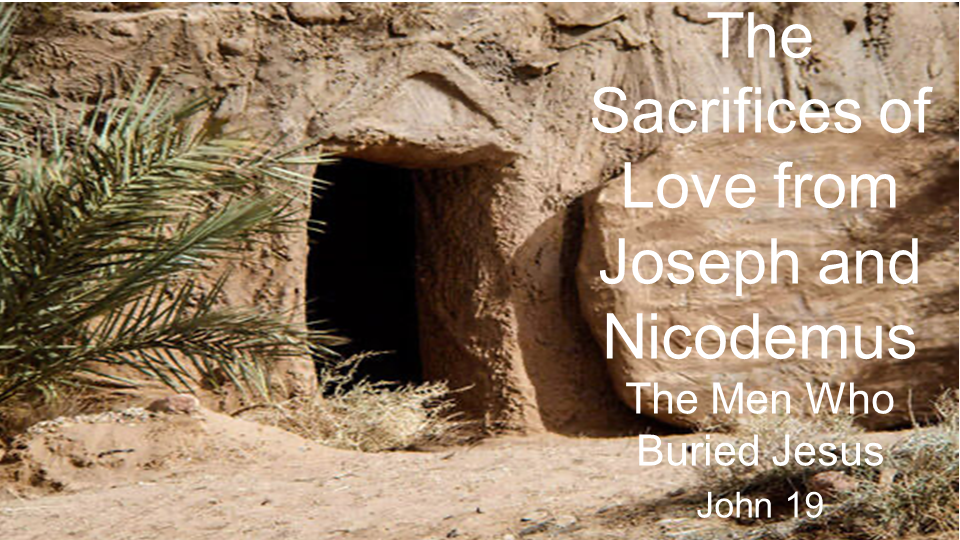
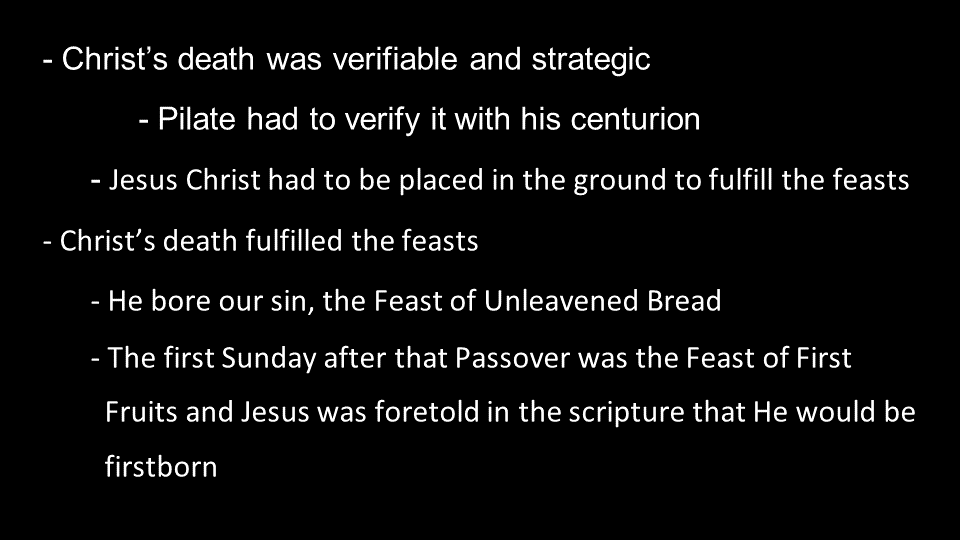
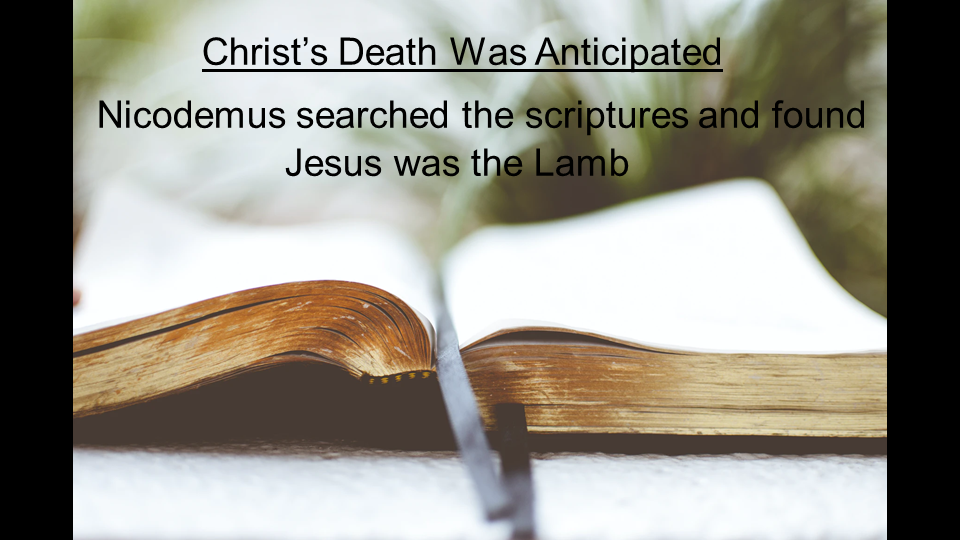

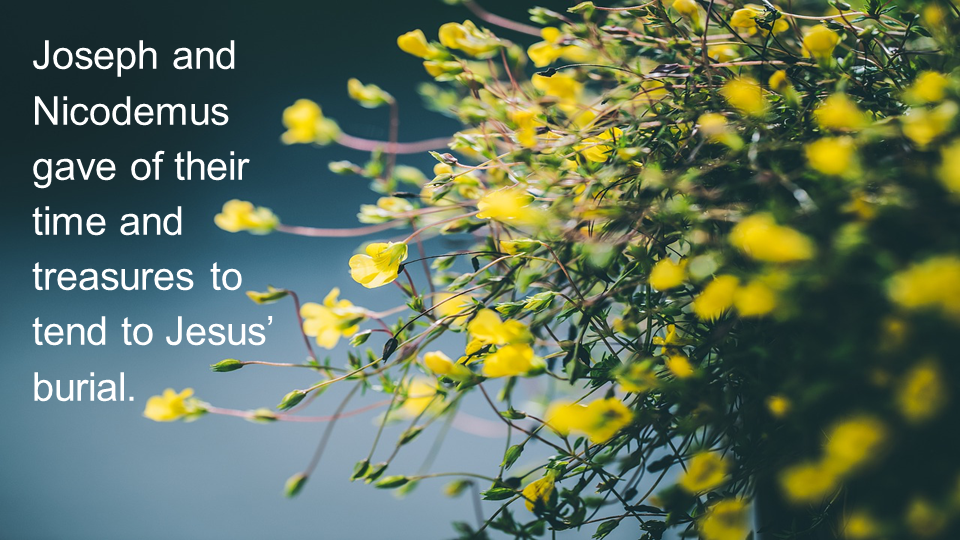


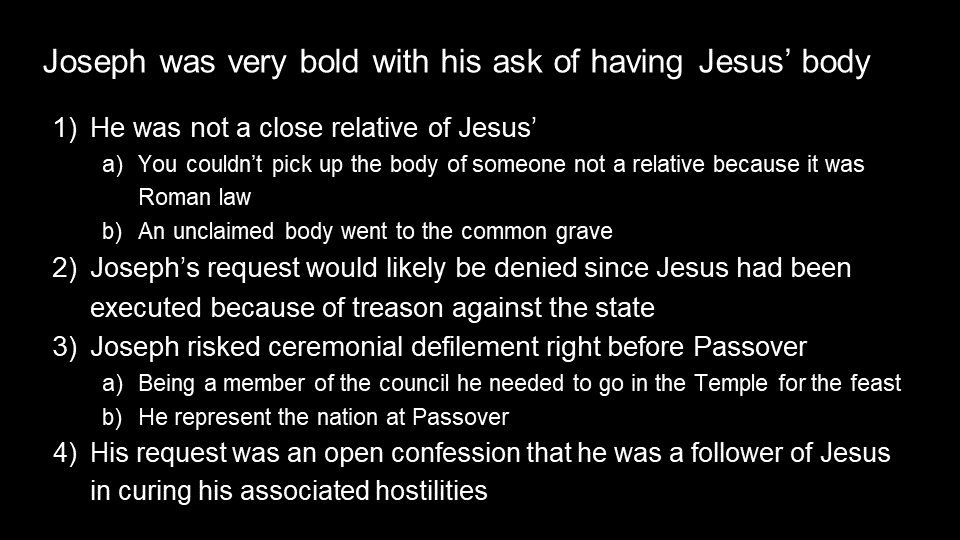
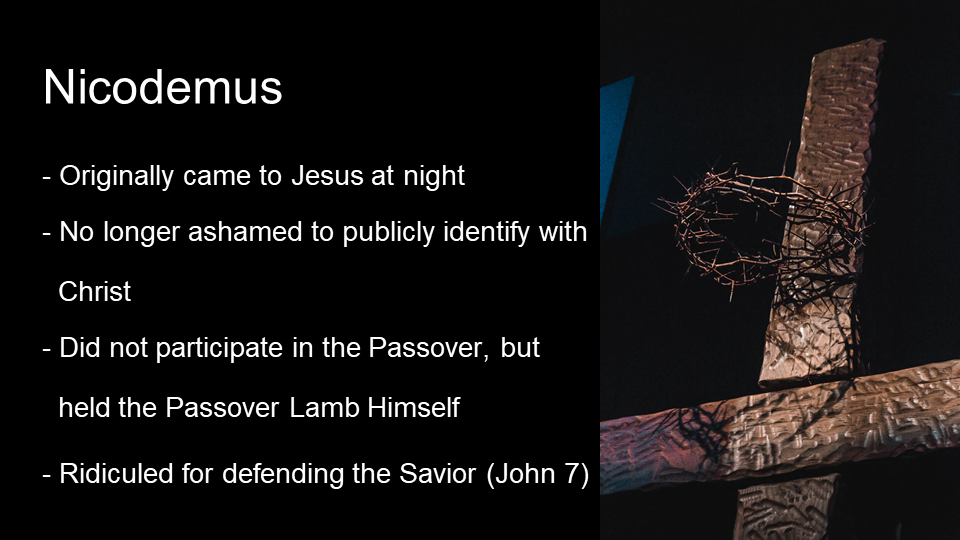
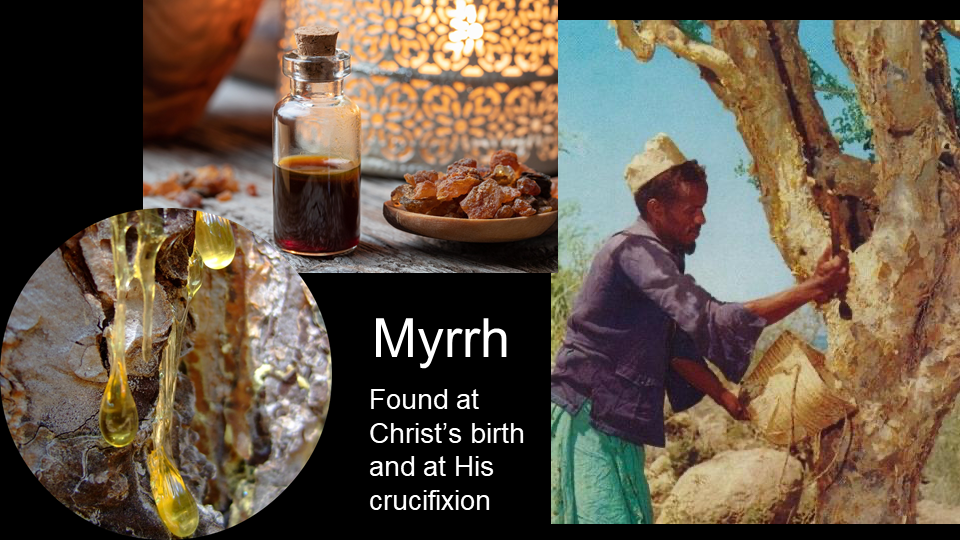
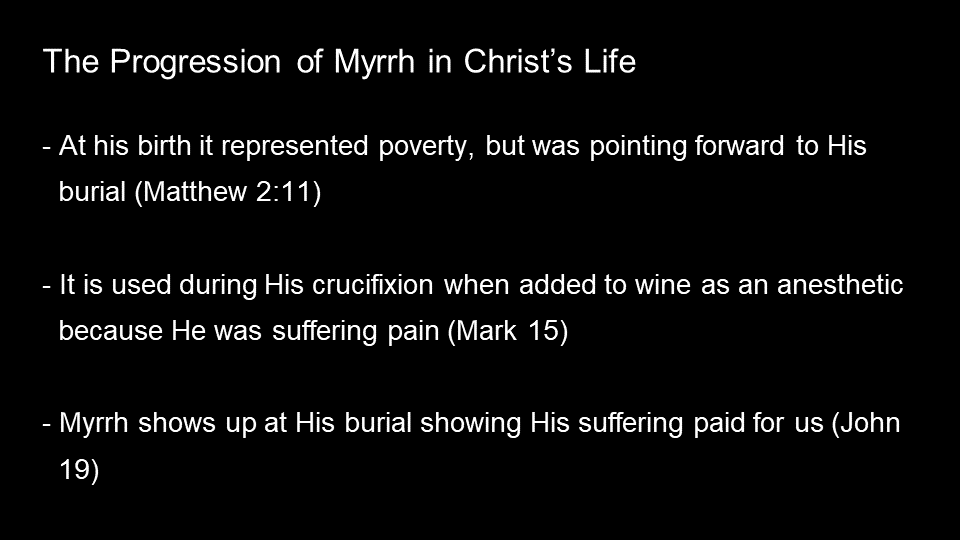

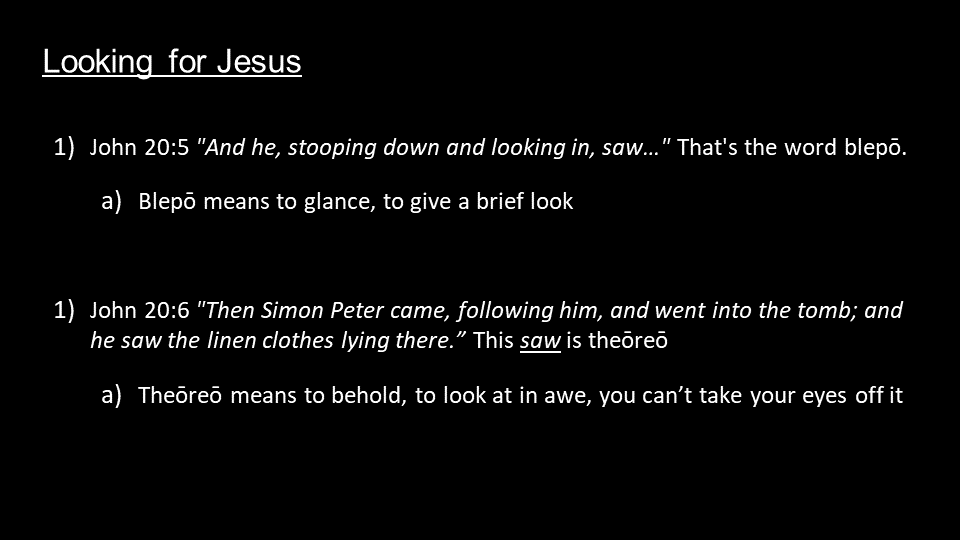
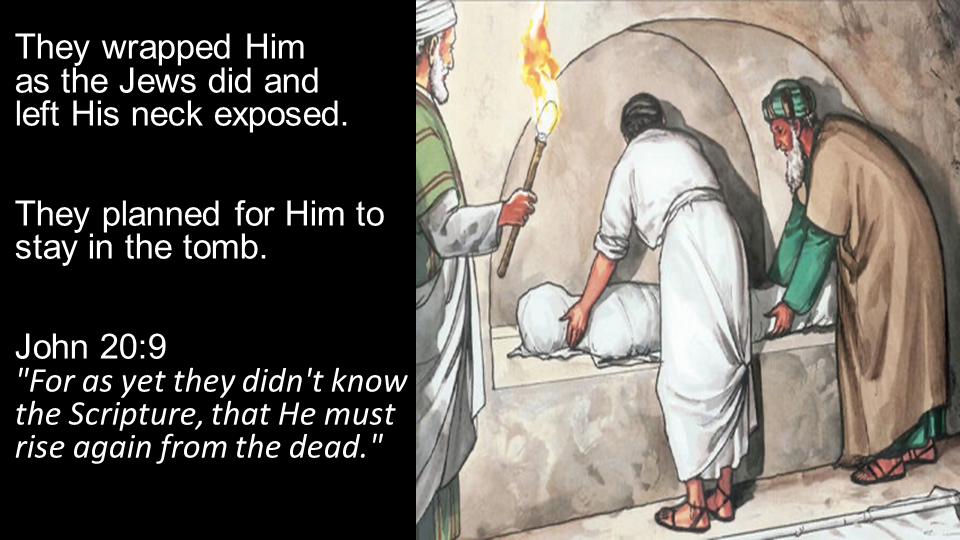

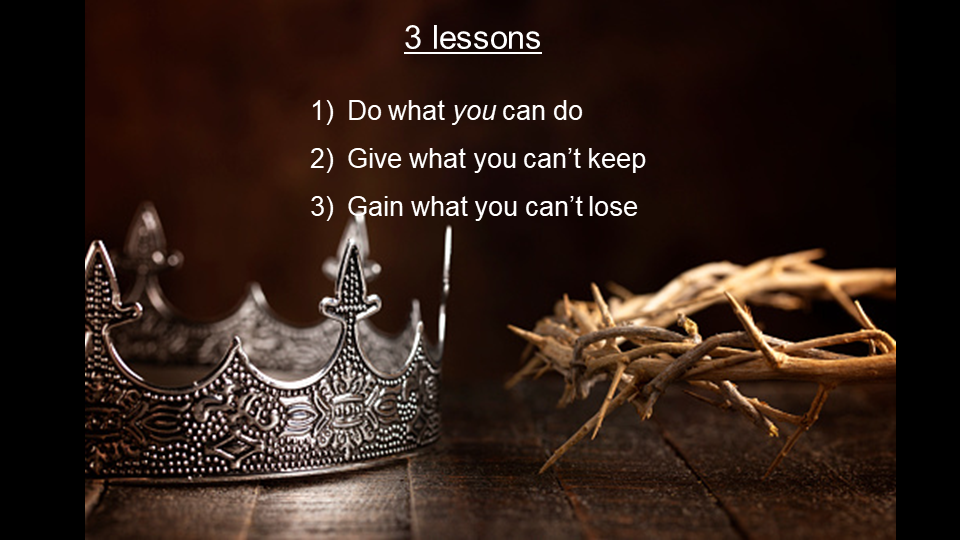
Dear Dr. Barnett,
Recently, I have been thinking about one of the same points you made in this presentation, that of Joseph’s and Nicodemus’ risking ceremonial defilement by handling the body of Jesus and preparing it for burial. Knowing that ceremonial uncleanness prohibited a Jew from participating in the Passover and partaking of the Passover lamb, I realised that, in their faith-filled act of burying their Messiah, they would have been considered ceremonially unclean and unable to eat the Passover. However, as you mentioned, they had held the Passover Lamb themselves.